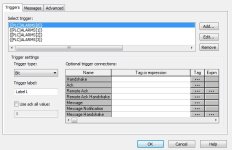stylemismatch
Member
The PLC for this application has DINT tags ALARMS[0], ALARMS[1], ALARMS[2] etc. Within each of those are individual alarm bits ALARMS[0].0, ALARMS[0].1 etc.
In the Alarm Trigger tab on the FactorTalkView, when I choose a tag from the PLC it doesn't let me choose down to the bit level (in other words it lets me choose ALARMS[0] for instance). I can then click 'edit' then click 'expn' and manually input the bit number (so now I have what I think I want - ALARMS[0].3 for instance).
Is this the right approach? (It just seems kind of odd to have to do it this way and I'd hate to have to go back and re-do all of this).
Thanks.
In the Alarm Trigger tab on the FactorTalkView, when I choose a tag from the PLC it doesn't let me choose down to the bit level (in other words it lets me choose ALARMS[0] for instance). I can then click 'edit' then click 'expn' and manually input the bit number (so now I have what I think I want - ALARMS[0].3 for instance).
Is this the right approach? (It just seems kind of odd to have to do it this way and I'd hate to have to go back and re-do all of this).
Thanks.





